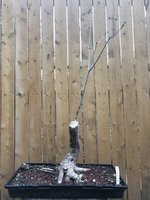I just read the start of this thread again. I didn’t realize Sergio had mistaken me for Doug until later on the thread. Doug gave Sergio the elm, then gave a collected hornbeam to
@JudyB, who gifted it to me the flowering year. Doug does that a lot...pass out stuff he’s collected.
As much as I’d like to take credit and say “you’re welcome Sergio” it was Doug.
On a side note, I was watching a video of Ryan Neil working on a quince and he mentioned Sergio using paper towel wrapped wire for certain species and he went on to mention what a talented artist he was. I’d absolutely agree with that.



